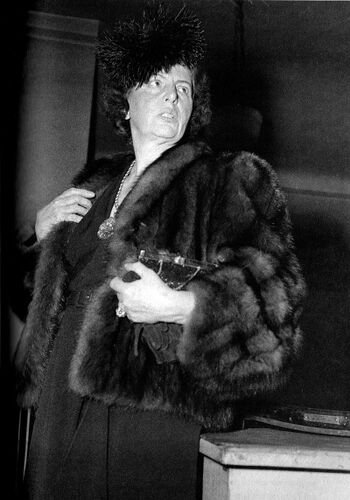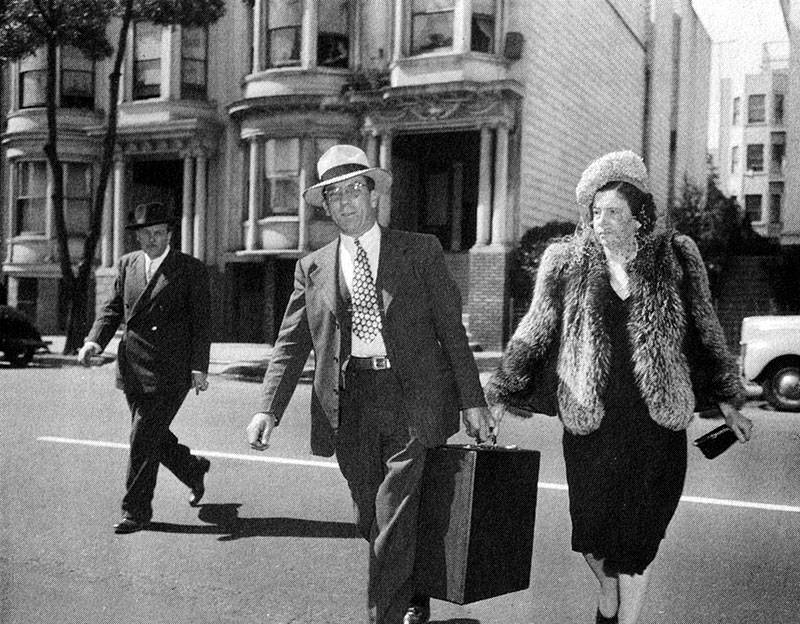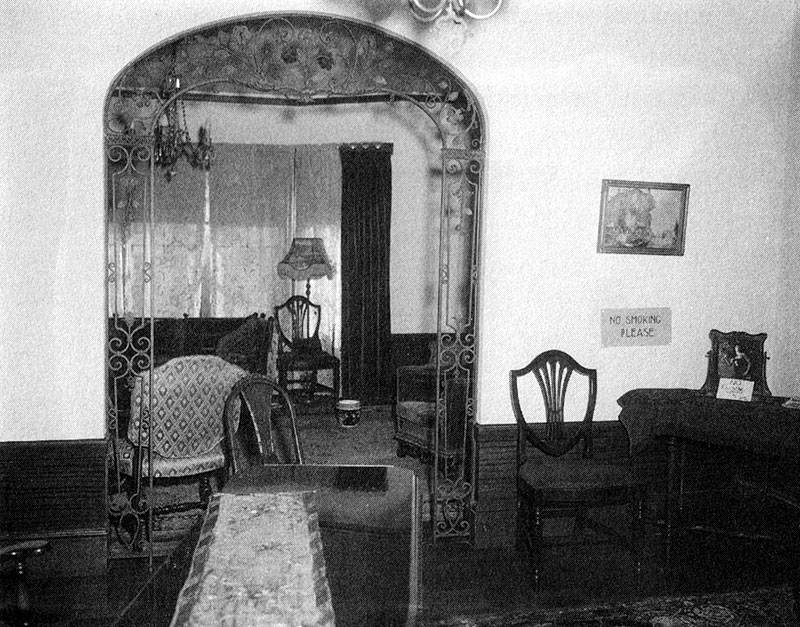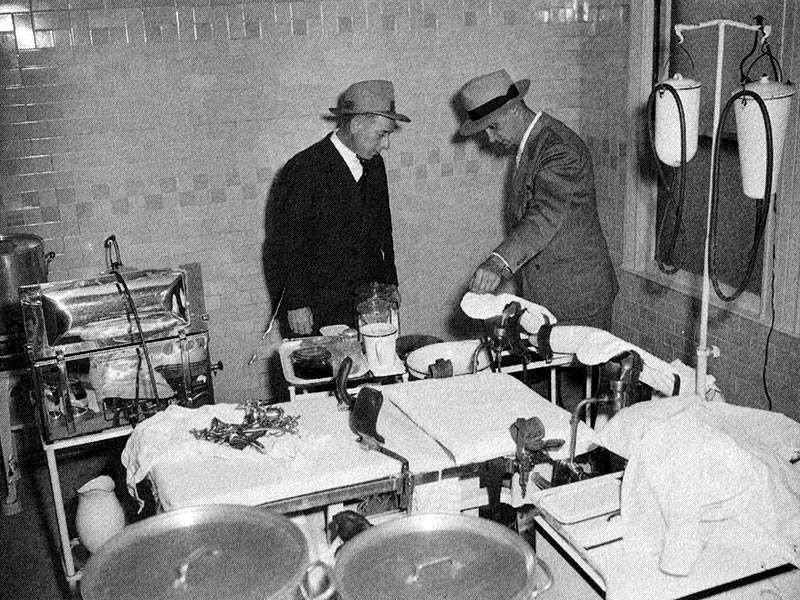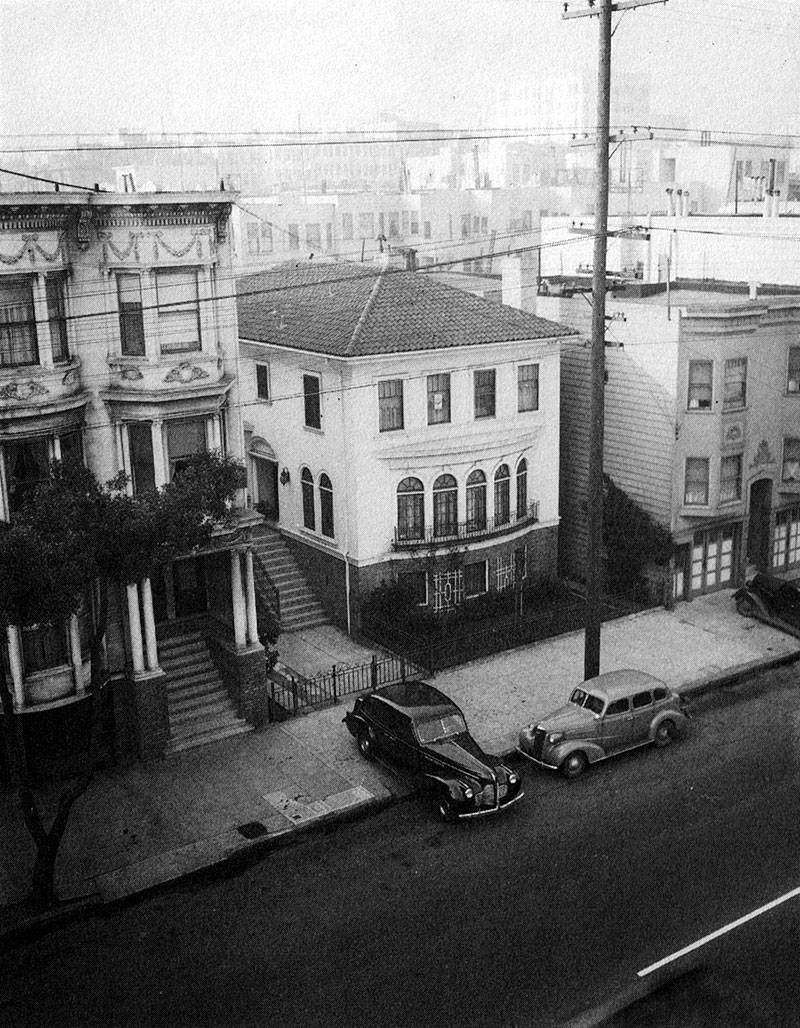Inez Burns: San Francisco’s Worst Kept Secret
Historical Essay
by Colleen Greisch, 2022
Note: This story is compiled from Stephen G. Bloom’s The Audacity of Inez Burns, Lisa Riggin’s San Francisco's Queen of Vice: The Strange Career of Abortionist Inez Burns, & various newspaper articles.
Inez Burns at Hall of Justice, September 22, 1945.
Photo: SF Examiner, courtesy Bancroft Library
San Francisco's most famous abortionist, Inez Burns, was born Inez Ingenthorn in San Francisco on September 5, 1886. The youngest child of a working-class family, she spent the first six years of her life in a tenement on 235 ½ Perry street in what was then considered South of the Slot (now known as SOMA). The family later relocated to a small apartment in Bernal Heights, where Inez spent most of her adolescence. With no formal schooling, Inez had few options for contributing to the family's finances. Desperate for money and a chance to rub elbows with the city's elite, 17-year-old Inez took a job as a manicurist at the opulent Palace Hotel. In those days, it was common for wealthy men to have their nails done in barbershops like the one housed in the Palace. While working at San Francisco's swankiest hotel, Inez learned how to use her good looks to attract the attention of the city's most influential and deep-pocketed men. One of those men, Dr. Eugene West, was one of San Francisco's most notorious physicians. Dr. West was an underground abortion provider whose ineptitude and malpractice routinely landed him in the courtroom. West had made headlines in 1902 when prosecutors charged him with dismembering former patient Addie Gilmour's body and disposing of her remains in the San Francisco bay. Not only was he acquitted of all charges, but the salacious trials only increased his visibility as a provider and resulted in the growth of his business. Overwhelmed by demand, Dr. West requested that Inez join the clinic as a receptionist and an assistant in the operating room.
Inez Burns and detective remove suitcase of cash from her Guerrero Street mansion, September 1945.
Photo: Bancroft Library, San Francisco Examiner collection, BANC PIC 2006.029-127616.04
Inez Burns gradually moved from assistant to West's full partner in the operation as he came to learn that she had a “sixth sense” when it came to abortions. She was a naturally skilled surgeon who was eager to perfect her craft. While money was the prime motivating factor, Inez was also passionate about her role in other women’s lives. She relished in providing fundamental rights at a time when women had so few. In the early 20th century, providing an abortion was a felony in every state, except when necessary to save a woman's life. These prohibitive laws, combined with a lack of access to birth control, forced women to seek the care of shoddy doctors for an exorbitant fee, attempt abortions on themselves using deadly methods, or resort to suicide for fear of being discovered as pregnant. Thus, providers were the principal gatekeepers for women seeking to terminate their pregnancies—a lucrative position that Inez pursued with great ambition.
City-wide destruction caused by the 1906 earthquake sent Inez to Pittsburgh where she worked at a pickle factory before returning to San Francisco in 1909 ready to start her own abortion practice. Early on, Inez performed abortions in a rented home in the Excelsior District. Rather than advertising her services in the newspaper using thinly coded language as was common practice then, Inez relied easily on word of mouth. This was in part because she had developed a reputation as a skilled and trustworthy provider, and her clinic was known for being meticulously clean. Inez quickly became one of California’s wealthiest women, raking in millions of dollars while the authorities (many of whom sent wives and mistresses to Burns) looked the other way. She became adept at paying off the San Francisco police force and buying her favor with local politicians. The bribes not only sustained her services which thousands of women relied on, but also as biographer Stephen G Bloom noted, “preserved much of the social fabric undergirding San Francisco and the rest of the state.” Inez was a treasure trove of secrets regarding the personal lives of elite politicians, lawyers, reporters, Hollywood starlets, and cops. It was in many individual’s best interests to keep Inez in business (and out of the courts) for fear of what a trial may have brought to light.
Inez Burns' Fillmore Street clinic reception room.
Photo: Bancroft Library
The sterile and professional facilities in the Fillmore Street abortion clinic.
Photo: Bancroft Library
The busy abortion clinic at 325-327 Fillmore Street, c. 1940s.
Photo: Bancroft Library
Inez Burns 325-327- Fillmore Street Abortion Clinic as seen in 2022.
Photo: Chris Carlsson
With the ability to operate relatively freely, Inez expanded her business in 1922 by opening a larger clinic in a two-story flat on 327 Fillmore street. Flush with cash, Inez transformed the flat into a full fledged surgical center replete with a spotless operating room, multiple recovery rooms, and a lavishly decorated waiting room. Understanding the inherent risk associated with her work, she took many steps to cover her tracks and protect herself from potential legal trouble. For instance, Inez installed a secret stairway to facilitate an escape in the event of a raid, and she built incinerators in the backyard to dispose of fetal remains. At the Fillmore clinic, Inez was performing an estimated 20- 40 abortions a day and charging between $75 and $200 per abortion. Her clientele was made up of primarily white married middle and upper class women who could afford the best in the business. Inez was the best. In 35 years of providing abortions, very few patients suffered abortion related complications or wound up in the hospital. Women with means traveled from near and far to receive Burn’s top notch care. Working class and poor women, on the other hand, were forced to either rely on sham opportunists who charged less or resort to even deadlier at-home methods.
The 274 Guerrero Street mansion in 1946.
Photo: Bancroft Library, BANC PIC 2006.029-127616-B.04.
Inez Burns' 274 Guerrero Street mansion, built with the proceeds of her lucrative decades-long underground abortion services.
Photo: Chris Carlsson, 2022
In 1924, Inez drew on her steady influx of cash to build an elegant fortress-like home at 274 Guerrero Street. 274 Guerrero is where Inez hid riches in custom-built secret compartments, sewed cash into the hems of drapes, and buried a fortune in the basement. Whether a result of Inez’s moxie or mere coincidence, 274 was also the number of the California penal code that outlawed abortion. Throughout the 1930s, Inez continued to build her abortion empire with few hiccups aside from a string of unsuccessful raids, dropped court charges, and a minor tax evasion settlement. This all started to change in 1943 when San Francisco elected a young and aspiring politician named Pat G. Brown to the office of District Attorney. Brown had campaigned on a platform of “vice cleanup” and “family values” and pledged to rid the city of perverse police corruption. Inez was the perfect pawn in Brown’s crusade against the underworld of San Francisco, and he pursued her relentlessly. In September of 1946, Inez Burns was convicted of performing illegal abortions. She ended up serving multiple prison terms due to later tax evasion convictions, and she died destitute in a nursing home at the age of 87. The case against Inez Burns elevated Pat Brown’s status as a politician, and he was later rewarded with stints as Attorney General and Governor of California.
While Brown solidified his status as a prominent California politico, women were left without access to what had been one of the nation’s safest and most trustworthy abortion clinics. With Inez Burns in prison, women in San Francisco and beyond were forced to seek out inept providers or resort to unsafe measures to terminate a pregnancy. Today, the Inez Burns story is as relevant as ever, as once again women’s reproductive rights are being used to advance political agendas. With the reversal of Roe vs. Wade, a new era of the abortion underground is already in motion.

